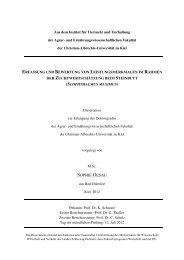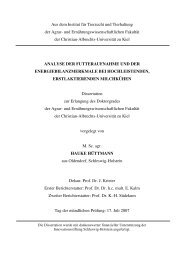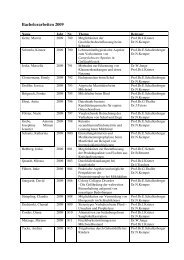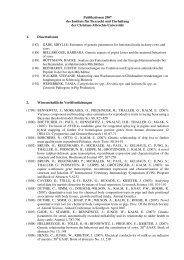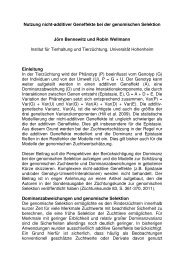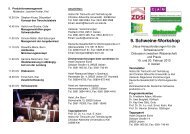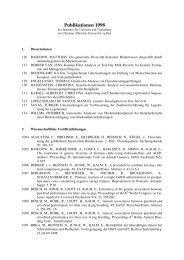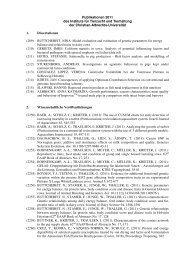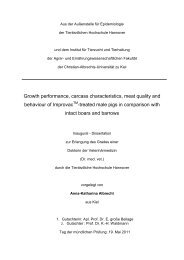Verena Gonzalez Lopez, 2011 - Institut für Tierzucht und Tierhaltung ...
Verena Gonzalez Lopez, 2011 - Institut für Tierzucht und Tierhaltung ...
Verena Gonzalez Lopez, 2011 - Institut für Tierzucht und Tierhaltung ...
Sie wollen auch ein ePaper? Erhöhen Sie die Reichweite Ihrer Titel.
YUMPU macht aus Druck-PDFs automatisch weboptimierte ePaper, die Google liebt.
Introduction<br />
In Germany, the Piétrain pig is bred by independent herdbook breeding organizations<br />
in which small numbers of specialized breeders are organized. With a proportion of<br />
72% of all inseminations, the Piétrain pig is the dominating sire breed in Germany.<br />
Since 1990 the number of Piétrain herdbook sows decreased substantially from<br />
10,431 to 3,329 in 2009 (ZDS, 2010). The structural change has led to cooperation<br />
between some herdbook organizations. In December 2008 eight breeding<br />
associations fo<strong>und</strong>ed the „Deutsche Herdbuchzucht Schwein“ (DHS). The declared<br />
aim is a closer collaboration in marketing, genetic evaluation and representation of<br />
interests. Three breeding organizations already implemented an overall breeding<br />
value system in September 2009. In future, this should be extended to all member<br />
organizations.<br />
An indispensable prerequisite of genetic evaluations across populations is an<br />
adequate genetic connectedness. A weak genetic connectedness will cause<br />
fluctuations in the estimation of the average genetic merit of populations and the<br />
genetic correlations between the same traits evaluated in different populations<br />
(Hanocq et al., 1996; Jorjani et al., 2005). The accuracy of estimated breeding values<br />
of individuals as well as genetic merit of populations increases with the degree of<br />
connectedness. Therefore, genetic evaluation with weakly linked populations is<br />
feasible, but not recommended (Mark et al., 2005). For this reason, it is essential to<br />
have detailed and quantitative information on the genetic connectedness between<br />
populations.<br />
In this context, the objective of this study was to analyze the genetic connectedness<br />
between the five most important Piétrain herdbook populations in Germany. Different<br />
methods are applied to quantify to which extent populations are genetically linked as<br />
a result of imported boars and the use of artificial insemination (AI) boars.<br />
Material and methods<br />
Data<br />
Piétrain pig populations from five regional, independent herdbook breeding<br />
organizations were studied. The breeding organizations were located in five regions<br />
in Germany: Schleswig-Holstein (SH), Lower Saxony (LS), North Rhine-Westphalia<br />
(NRW), Baden-Württemberg (BW), and Bavaria (B). Pedigree records were obtained<br />
from the Chamber of Agriculture Schleswig-Holstein for the herdbook populations in<br />
21



